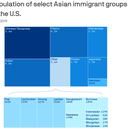Diversity of Asian Americans shatters the "model minority myth"

Asian Americans hail from dozens of countries — and their experiences in America are starkly different depending on their origins.
Why it matters: This vast, diverse group is often lumped together under the "model minority myth" — the stereotype that all Asian Americans are well-educated, wealthy and successful.
- If you look at averages, Asian Americans appear to be richer and better educated than the average American.
- If you disaggregate the data, the model minority myth crumbles. We see high levels of poverty and below-average levels of educational attainment.
But because that data is seldom disaggregated, "Asian Americans have had to make the case over and over again that they suffer from racism and hostility and violence," says Ellen Wu, a history professor at Indiana University.
The big picture: The U.S. Asian American population doubled from 2000 to 2019, hitting 22 million. Asians are the fastest-growing group in America — outpacing white, Black and Hispanic Americans and projected to pass 46 million by 2060, according to the Pew Research Center.
- "They all have very different starting points," says Neil Ruiz, associate director of race and ethnicity research at the Pew Research Center.
- Consider, for example, an Indian immigrant who comes to the U.S. via H-1B visa for a high-paying gig at a tech company. That person will have a far easier time building generational wealth than a Burmese refugee coming to America to escape conflict, Ruiz says.
By the numbers: The median income of Asian households in the U.S is $85,800, and 54% have college degrees, per Pew.
- But only three groups — Indians, Filipinos and Sri Lankans — fall above that household income. And college attainment for many groups is well below the average.
The stakes: "So many groups have been neglected and ignored," says Quyên Dinh, executive director of the Southeast Asia Resource Action Center.
- "People are not always convinced that Asian Americans are a legitimate minority group that deserve to be included in affirmative action and diversity initiatives," says Wu.
- For example, 30% of Southeast Asians — a region encompassing nations like Cambodia, Vietnam and Laos — don't have high school degrees.
- "Because of the model minority myth, these students' silence in classrooms is misinterpreted as understanding instead of a cry for help," Dinh says.
What to watch: Activists and experts see a silver lining in the recent spikes in anti-Asian violence. "There is a new spotlight on the Asian American community," says Dinh.
- "Awful things have always happened," Wu says. "But now Asians are collecting the data and recording what's happening, and Asian journalists are amplifying these stories."